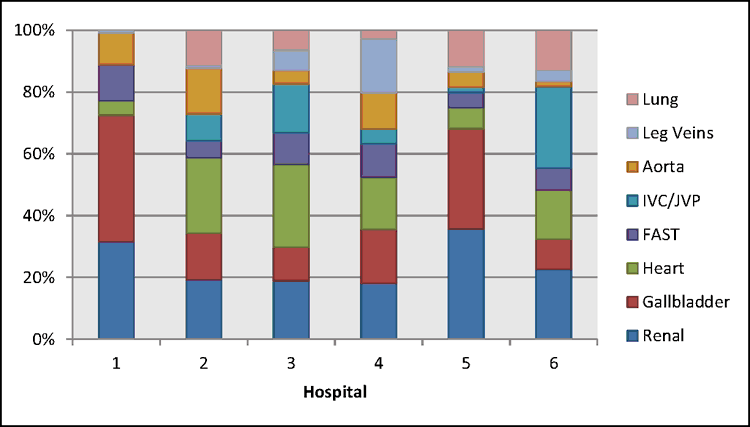Scope of point-of-care ultrasound practice in rural New Zealand
Garry Nixon 1 , Kati Blattner 1 , Jillian Muirhead 1 , Wendy Finnie 1 , Ross Lawrenson 2 , Ngaire Kerse 31 Dunedin School of Medicine, University of Otago, Dunedin, New Zealand
2 Medical Research Centre, University of Waikato and Waikato District Health Board, New Zealand
3 School of Population Health, University of Auckland, Tamaki, Auckland, New Zealand
Correspondence to: Garry Nixon, Dunedin School of Medicine, University of Otago, Dunedin, New Zealand. Email: garry.nixon@otago.ac.nz
Journal of Primary Health Care 10(3) 224-236 https://doi.org/10.1071/HC18031
Published: 28 August 2018
Journal Compilation © Royal New Zealand College of General Practitioners 2018.
This is an open access article licensed under a Creative Commons Attribution-NonCommercial-NoDerivatives 4.0 International License.
Abstract
INTRODUCTION: Point-of-care ultrasound (POCUS) is an increasingly common adjunct to the clinical assessment of patients in rural New Zealand.
AIM: To describe the scope of POCUS being practiced by rural generalist hospital doctors and gain insights, from their perspective, into its effect.
METHODS: This was a mixed-methods descriptive study. Main outcome measures were type and frequency of POCUS being undertaken. A questionnaire was given to POCUS-active rural hospital doctors to survey the effect of POCUS on clinical practice and assess issues of quality assurance.
RESULTS: The most commonly performed scans were: cardiac (18%) and volume scans (inferior vena cava and jugular venous pressure) (14%), followed by gallbladder (13%), kidney (11%), Focused Assessment with Sonography in Trauma (FAST) (7%), bladder (6%), leg veins (6%) and lungs (5%). There was large variation in frequency of scan types between the study hospitals that could not be accounted for by differences in training.
DISCUSSION: Rural generalists consider the broad scope of POCUS they practise to be an important but challenging skill set. Clinical governance, including an agreed scope and standards, may increase the benefits and improve the safety of rural POCUS.
KEYWORDS: Rural hospital; rural medical education; diagnostic imaging; rural health services
| WHAT GAP THIS FILLS |
| What is already known: Point-of-care ultrasound (POCUS) is being used increasingly across the medical specialties in urban hospitals globally and in Australasian emergency departments. POCUS is a user-dependent technology and requires appropriate training and quality assurance. |
| What this study adds: Rural generalist doctors have a broad scope of POCUS practice that is different from their emergency medicine colleagues. Rural doctors consider that POCUS has a positive effect on their practice, but are concerned about the absence of agreed standards and quality assurance systems. |
Introduction
Ultrasound was traditionally the domain of sonographers, specialist radiologists and cardiologists. This has changed with the emergence of point-of-care ultrasound (POCUS), which is now used in a range of specialties for both diagnosis and to guide procedures.1 The potential diagnostic value of POCUS may be greatest in rural settings where access to formal ultrasound, and imaging modalities generally, is limited.
POCUS has been advocated both in rural settings and in the hands of generalist hospital doctors dealing with inpatients.2, 3 However, apart from one study of 43 patients in a rural emergency department in the USA, surveys of rural physicians in Ontario and Quebec, and others in the very remote or wilderness settings, there are no published papers that describe the scope of POCUS being practiced by rural generalists or its effect on patient management in the rural context.1, 4– 8
Rural doctors are learning POCUS skills. This is evidenced by more than 250 graduates of the University of Otago Postgraduate Certificate in Clinician-Performed Ultrasound (PGCertCPU) since its inception in 2006.9 The Australian College of Rural and Remote Medicine and other providers run similar courses in Australia.10
Rural generalist medicine encompasses primary, inpatient and emergency care and requires some advanced skills.11 A consequence of broad scopes of practice is lower volumes of any particular presentation or procedure. This raises important issues around maintaining competence and patient safety. We are unaware of efforts by any professional college or credentialing body to recognise a scope of practice or set standards for rural POCUS, although policies have been developed by the Australasian College of Emergency Medicine for their members.12
The aim of this research was to provide an overview of diagnostic POCUS in a sample of New Zealand rural hospitals. The study measures the volume and range of POCUS examinations being undertaken and, using a questionnaire, provides perspectives of the effect of POCUS from the point of view of participating doctors. This analysis is part of a larger study that evaluates the ability of generalist rural doctors to obtain and correctly interpret POCUS images and to assess the effect of POCUS on patient care. The intention is to collect information that will inform appropriate training, policy and resourcing for rural POCUS.
Methods
The quantitative and qualitative data in this mixed-methods study are analysed concurrently but separately, and integrated during interpretation, described as an ‘integrative process’.13
The study was conducted in six rural hospitals. These hospitals represent the geographic and sociodemographic diversity of rural New Zealand, collectively accounting for 25% of all the country’s rural hospitals.14 These hospitals are staffed by general practitioners and hospital generalists. None of the hospitals have surgical capabilities or on-site surgeons. Two hospitals are integrated with general practice. The catchment populations and distance to the nearest base hospital are presented in Table 1. All the generalist rural doctors practising POCUS in these hospitals during the study period were eligible for inclusion and invited to participate in the study.
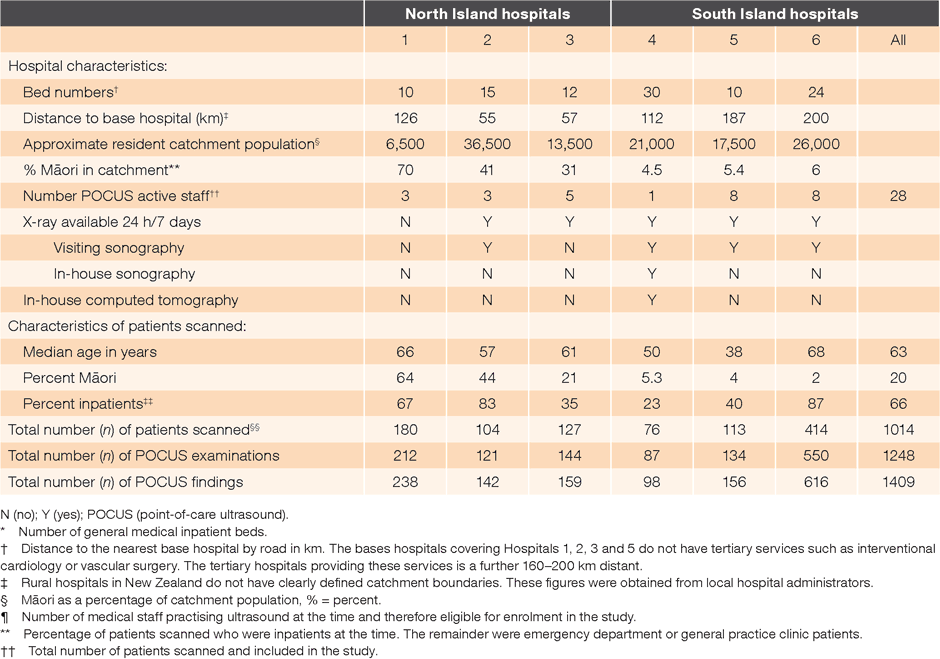
|
Quantitative data collection and analysis
Each time they undertook POCUS as part of their routine clinical duties, the participating doctors completed a form (Appendix 1) that, in addition to the patient’s age, ethnicity and gender (via the National Health Index Number), captured details about the type of POCUS examinations, POCUS findings and whether the doctor asked for the images to be reviewed. Scans undertaken principally for training or to guide procedures were not included in this study. Participating doctors were encouraged to record all scans performed over a 9-month period in 2012.
Descriptive statistics were used to summarise the number and type of POCUS examinations undertaken, as well as the characteristics of patients. Differences in scan frequency between the hospitals and doctors working in multiple hospitals were corrected for, using a generalised linear mixed model with a Poisson distribution, and the interaction between doctor and POCUS scan type as random term. The Poisson distribution with the log link was chosen, as this regression can be used for multinomial distributions.15 The Function ‘glmer’ in the R package lme4 was used for the analysis.16
Qualitative data collection and analysis
Three months after the completion of the quantitative data collection, participants were asked to complete a questionnaire that included questions about the effect of POCUS on patient management, quality assurance and credentialing, and the implementation of POCUS in their rural hospital (Appendix 2). The written responses were entered into an Excel spreadsheet (Microsoft Corporation, Redmond, WA, USA) according to the categories used in the questionnaire. After review by the research team, responses were collated into categories that related to the original questions, capturing the main issues. Participant responses were reported as summaries and quotes. To maintain participant anonymity, all respondents were designated a number (1–17) and were referred to throughout the study by this coding (e.g. Respondent 5 or R5).
Ethics approval for the study was obtained from the Multi Region Ethics Committee MEC/10/09/091 and consent was obtained from the participating doctors.
Results
Quantitative results
Twenty-eight doctors enrolled in the study; one eligible doctor declined to participate. POCUS scans were conducted and forms completed for 1044 patients. Of these, 30 were excluded because there was incorrect or inadequate patient information on the form. Scans from 1014 patients were included in the study. Many scans involved more than one type of examination (e.g. gallbladder and kidney). The 1014 patients underwent 1247 examinations.
Age data were missing for 16 patients. The youngest patient scanned was aged 1 year, the oldest was aged 102 years and the median age was 63 years. Ethnicity data were missing for eight patients. Overall, 78% of patients scanned were European, 20% Māori and 2% were of other ethnicities.
The frequency of each POCUS examination is shown in Table 2. The most commonly performed examinations were cardiac scans and scans assessing intravascular volume (inferior vena cava diameter and jugular venous pressure).
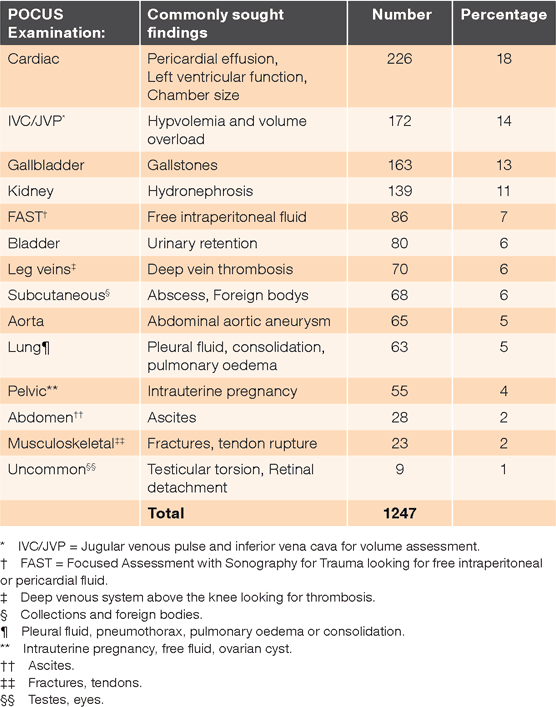
|
Even after correcting for variation between the participating doctors, there remained a significant variation between the hospitals in the frequency of scan types that were performed (P < 0.001). This is shown in Figure 1.
In only 3% of cases, participants reviewed the images with a colleague in person or by sharing them electronically. If this occurred, it was most likely to have been with a sonographer, an echocardiographer or a cardiologist.
Qualitative results
Twenty-three of the participating doctors were still working in the study hospitals when the questionnaire was undertaken; five had moved to work elsewhere. Seventeen completed and returned the questionnaire (17/23, 74% response).
The key findings are summarised in three main categories. Examples in the form of quotes are presented in Table 3 for each category.
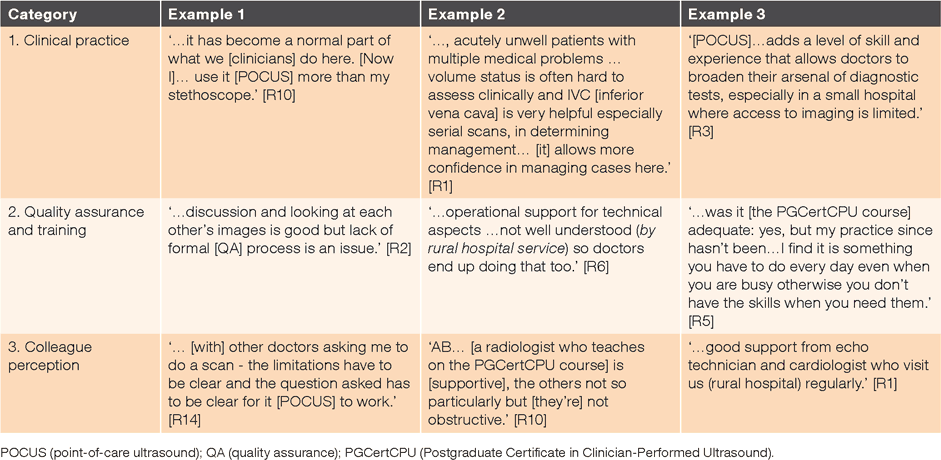
|
Clinical Practice: POCUS made a valuable impact on patient management largely by adding to diagnostic certainty. Respondents enjoyed using their new and practical POCUS skill and regarded scanning as an extension of their clinical examination.
Training and quality assurance: Fifteen out of the 17 respondents were graduates of the University of Otago’s PGCertCPU, a year-long programme that includes three workshops and an online learning platform.9 One had attended a week-long course in Australia and the other had learned ultrasound in his undergraduate medical education in Germany.
Respondents were conscious of POCUS scope limitations and their need for ongoing training. Respondents mentioned the pressure of ongoing maintenance of their competency in POCUS in the context of the already challenging scopes of practice in rural hospitals. No respondents were aware of any formal POCUS Quality Assurance or credentialing systems in New Zealand. Respondents commented on the need for their hospitals to incorporate systems for set up and maintenance of POCUS equipment (including download, storage and transmission of images) into routine operations (Table 4).
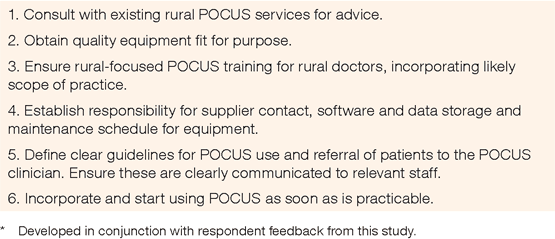
|
Colleague perception: While some respondents experienced negative responses from urban specialist colleagues, others indicated a growing acceptance by these same specialists of POCUS and its value in the rural context. Particular support was noted from specialists who regularly visited the rural centres.
While the POCUS-trained rural clinicians had a good understanding of their POCUS scope and its limitations, rural colleague perception of POCUS scope varied. Several respondents found referrals from onsite colleagues who were not POCUS trained difficult to manage because of the expectation that they should perform stand-alone ultrasound examinations rather than incorporating it as part of clinical assessments.
Respondents valued being involved in the research and more than half of the respondents specified that the rural provenance of the study was key in prompting their participation and interest in the research.
Discussion
The notable quantitative findings in this study are a scope of rural POCUS that is broad, relatively complex and varies considerably between hospitals. Cardiac scans, arguably the technically most difficult, were the most commonly performed, while Focused Assessment with Sonography in Trauma (FAST) and aorta scans, which are more straightforward POCUS examinations and the most commonly performed scans in emergency departments, were only the fifth and ninth most frequently undertaken in this study.6, 17, 18 This broad scope of rural POCUS reflects the scope of rural generalist medicine, a context that is typified by poor access to complex diagnostic imaging.11, 19
This same breadth and complexity of POCUS may underlie the concerns the participants expressed about the limitations of their personal POCUS skills, the lack of formal quality assurance processes and very limited opportunities for ongoing training.
The absence of a recognised scope and clinical governance for rural POCUS may also be reasons for other study findings: the absence of systems to maintain machines and download and store images; the limited understanding of rural POCUS by health-care managers and urban colleagues; low rates of image review with colleagues or specialists; and the large variation in frequency of POCUS examinations between the study hospitals. This last finding was unexpected and cannot be explained by differences in training, as most of the participants graduated from the same university-based POCUS course. Equally, while there are differences in the demographics of the hospital catchment populations, these are insufficient to explain the variation we observed. Each hospital is in a sense ‘doing their own thing’.
This study recorded only a very small number of obstetric scans. This finding was expected and reflects how few generalist doctors in New Zealand now practice obstetrics.20 This may represent a missed opportunity for rural doctors and midwives. Australian rural doctors consider obstetric scanning to be an important part of their POCUS practice.21
Patients of Māori ethnicity comprised 20% of the patients scanned, but 27% of the hospital catchments’ population base. Potential explanations include the younger age profile of the Māori population, but older age of patients being scanned. In one of the northern communities, 88% of patients aged <25 years are Māori, but only 61% of patients are aged >45years, and the median age of scanned patients was 66 years. The hospital catchment populations are estimates obtained from local hospital managers. This further complicates these calculations and makes it difficult to generate age-standardised rates. Two of the southern hospitals are in tourist centres and it is unknown how many of the patients scanned were non-residents. The institutions and their clinicians must, however, consider the possibility that these results reflect systemic bias, and future audits and studies designed to test this will be needed.
In this study, the North Island rural hospitals were smaller, further away from tertiary services and had less access to imaging than their South Island counterparts (see Table 1 for a summary). These same hospitals serve large Māori populations. Māori are disadvantaged in health outcomes and access to health services, and rural Māori may face even greater disadvantages than their urban counterparts.22 This underscores the need for, and importance of, equitable and safe POCUS services for to all rural communities.
The rural ‘ownership’ of this study was important for the participants, and supports previous findings that research developed in consultation with rural communities and health-care providers, and embedded in rural areas, is more likely to align with the health-care aspirations of rural communities.23
This is the first research to describe the use of POCUS in rural hospitals and one of the largest studies to describe its use in day-to-day clinical practice in any context. The qualitative component of the study is limited by the methodology; collated responses from a written questionnaire lack the depth that could be gained from other qualitative research methods. The real-world nature of the study and geographic and demographic spread of the hospitals are strengths of the study. While doctors were strongly encouraged to include all the scans they undertook during the study period, we were unable to ascertain how many examinations were not reported. POCUS is an evolving field and it is likely the skills of rural practitioners will have developed further since this study was undertaken in 2012. However, the scope of POCUS taught to PGCertCPU students in 2018 is, apart from the addition of some lung ultrasound, unchanged from 2012.9 Importantly, quality assurance and credentialing processes for POCUS in most rural hospitals have not progressed.
In light of these study findings, the authors recommend that clinical governance be implemented for rural POCUS in New Zealand, so that safe scopes of practice, credentialing and quality assurance can be maintained. Given the size of New Zealand’s hospitals, it may be appropriate for this governance to be provided by the hospitals collectively or through the Royal New Zealand College of General Practitioners. This process should be informed by further rurally based research into the outcomes of POCUS.
COMPETING INTERESTS
None.
ACKNOWLEDGEMENTS
Dr Rosylne McKechnie and Ms Bron Hunt administered the data collection and analysis, and liaised with the participants. Bert Vanderwerf helped with the statistical analysis.
References
[1] Moore CL, Copel JA. Point-of-care ultrasonography. N Engl J Med. 2011; 364 749–57.| Point-of-care ultrasonography.Crossref | GoogleScholarGoogle Scholar |
[2] Minardi J, Davidov D, Denne N,, et al. Bedside ultrasound: advanced technology to improve rural healthcare. W V Med J. 2013; 109 28–33.
[3] Soni NJ, Lucas BP. Diagnostic point-of-care ultrasound for hospitalists. J Hosp Med. 2015; 10 120–4.
| Diagnostic point-of-care ultrasound for hospitalists.Crossref | GoogleScholarGoogle Scholar |
[4] Lyon M, Blaivas M, Brannam L. Use of emergency ultrasound in a rural ED with limited radiology services. Am J Emerg Med. 2005; 23 212–4.
| Use of emergency ultrasound in a rural ED with limited radiology services.Crossref | GoogleScholarGoogle Scholar |
[5] Flynn CJ, Weppler A, Theodoro D,, et al. Emergency medicine ultrasonography in rural communities. Can J Rural Med. 2012; 17 99–104.
[6] Léger P, Fleet R, Maltais-Giguere J,, et al. A majority of rural emergency departments in the province of Quebec use point-of-care ultrasound: a cross-sectional survey. BMC Emerg Med. 2015; 15 36
| A majority of rural emergency departments in the province of Quebec use point-of-care ultrasound: a cross-sectional survey.Crossref | GoogleScholarGoogle Scholar |
[7] Nelson BP, Melnick ER, Li J. Portable ultrasound for remote environments, part II: current indications. J Emerg Med. 2011; 40 313–21.
| Portable ultrasound for remote environments, part II: current indications.Crossref | GoogleScholarGoogle Scholar |
[8] Blaivas M, Kuhn W, Reynolds B, Brannam L. Change in differential diagnosis and patient management with the use of portable ultrasound in a remote setting. Wilderness Environ Med. 2005; 16 38–41.
| Change in differential diagnosis and patient management with the use of portable ultrasound in a remote setting.Crossref | GoogleScholarGoogle Scholar |
[9] Wong, Y., Postgraduate Certificate in Clinician Performed Ultrasound. Dunedin: University of Otago; 2017. [cited 2018 July 20]. Available from: https://www.otago.ac.nz/dsm-rural-postg/study/otago625729.html
[10] Glazebrook R, Manahan D, Chater AB. Evaluation of an ultrasound program (intermediate obstetric and emergency medicine) for Australian rural and remote doctors. Aust J Rural Health. 2005; 13 295–9.
| Evaluation of an ultrasound program (intermediate obstetric and emergency medicine) for Australian rural and remote doctors.Crossref | GoogleScholarGoogle Scholar |
[11] Murray, R. Cairns Consensus Statement 2013. Cairns: Australian College of Rural and Remote Medicine; 2014. [cited 2018 January 01]. Available from: http://www.ruralgeneralismsummit.net/cairns-consensus-statement-on-rural-generalist-medicine/
[12] ED Ultrasound Subcommittee. Policy on credentialing for emergency medicine ultrasonography: Trauma Examination and suspected AAA. Australasian College for Emergency Medicine; 2016. [cited 2018 July 20]. Available from: https://acem.org.au/getmedia/437ab6b0-3ff4-49ff-94fa-588637b53d11/Feb_16_P22_Credentialing_for_EM_US_Trauma-SuspectedAAA.aspx.
[13] Zhang W, Creswell J. The use of “mixing” procedure of mixed methods in health services research. Med Care. 2013; 51 e51–7.
| The use of “mixing” procedure of mixed methods in health services research.Crossref | GoogleScholarGoogle Scholar |
[14] Lawrenson R, Reid J, Nixon G, Laurenson A. The New Zealand Rural Hospital Doctors Workforce Survey 2015. N Z Med J. 2016; 129 9–16.
[15] Agresti A. Categorical Data Analysis, 3rd edn, New York: Wiley; 2013.
[16] Bates D, Maechler M, Bolker B, Walker S. Fitting Linear Mixed-Effects Models using lme4. J Stat Softw. 2015; 67
| Fitting Linear Mixed-Effects Models using lme4.Crossref | GoogleScholarGoogle Scholar |
[17] Nagaraj G, Chu M, Dinh M. Emergency clinician performed ultrasound: availability, uses and credentialing in Australian emergency departments. Emerg Med Australas. 2010; 22 296–300.
| Emergency clinician performed ultrasound: availability, uses and credentialing in Australian emergency departments.Crossref | GoogleScholarGoogle Scholar |
[18] Craig S, Egerton-Warburton D, Mellett T. Ultrasound use in Australasian emergency departments: A survey of Australasian College for Emergency Medicine Fellows and Trainees. Emerg Med Australas. 2014; 26 268–73.
| Ultrasound use in Australasian emergency departments: A survey of Australasian College for Emergency Medicine Fellows and Trainees.Crossref | GoogleScholarGoogle Scholar |
[19] Williamson M, Gormley A, Dovey S, Farry P. Rural hospitals in New Zealand: results from a survey. N Z Med J. 2010; 123 20–9.
[20] Jaye C, Mason Z, Miller D. “Tossing out the baby with the bath water”: New Zealand general practitioners on maternity care. Med Anthropol. 2013; 32 448–66.
| “Tossing out the baby with the bath water”: New Zealand general practitioners on maternity care.Crossref | GoogleScholarGoogle Scholar |
[21] Glazebrook R, Manahan D, Chater B,, et al. Educational needs of rural and remote Australian non-specialist medical practitioners for obstetric ultrasound. Aust J Rural Health. 2004; 12 73–80.
| Educational needs of rural and remote Australian non-specialist medical practitioners for obstetric ultrasound.Crossref | GoogleScholarGoogle Scholar |
[22] Robson B, Simmonds S, Findlay N. Mātātuhi Tuawhenua: Health of Rūral Māori 2012. Wellington, NZ: Ministry of Health; 2012.
[23] Lightfoot N, Strasser R, Maar M, Jacklin K. Challenges and rewards of health research in northern, rural, and remote communities. Ann Epidemiol. 2008; 18 507–14.
| Challenges and rewards of health research in northern, rural, and remote communities.Crossref | GoogleScholarGoogle Scholar |
Appendix 1 Data collection form
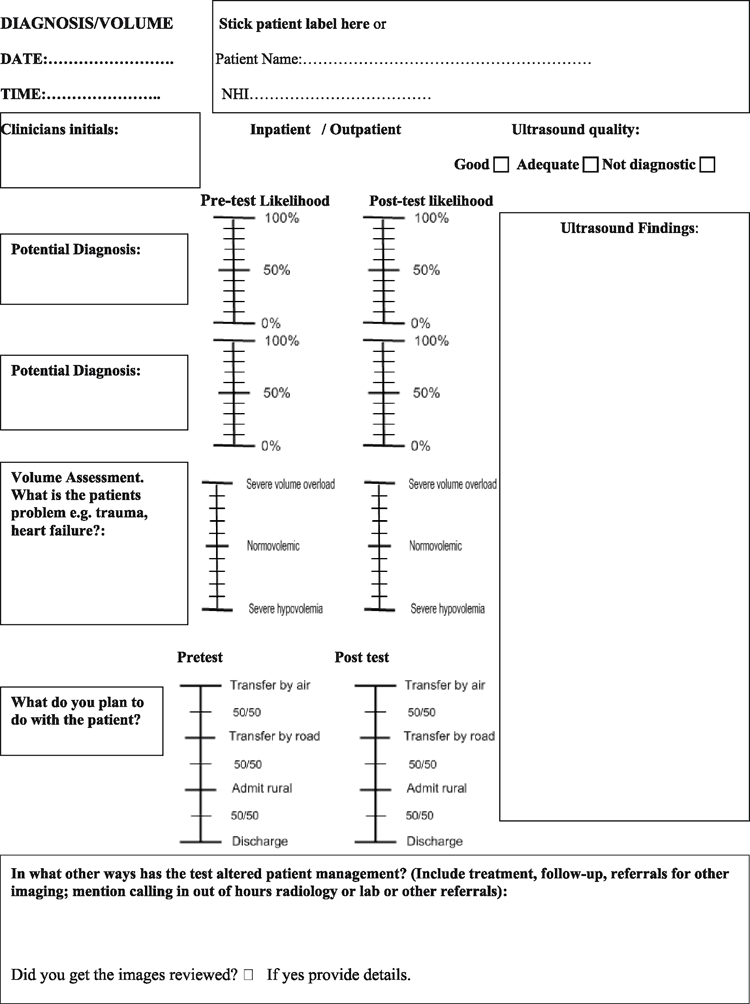
|
Appendix 2 Participant questionnaire

|


